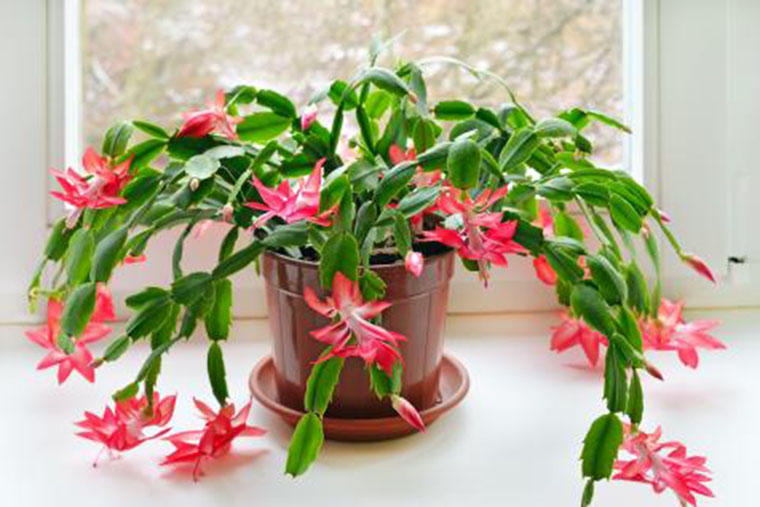All About Holiday Cacti
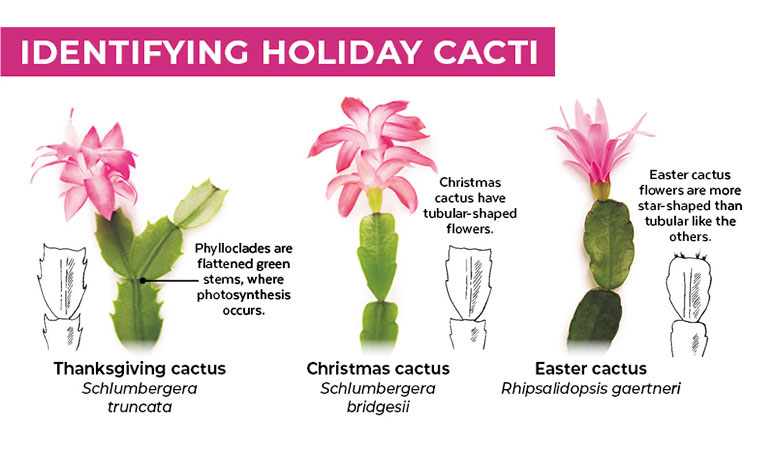
Holiday Cacti belong to the genus Schlumbergera, a flowering cactus family originating in the coastal mountains of Brazil. These plants grow on trees or rocks in habitats that are generally shady with high humidity. Most species of Schlumbergera have stems that resemble leaf-like pads joined one to the other and flowers that appear at the joints and tips of the stems.
Most of the popular houseplants are cultivars with flowers in white, pink, yellow, orange, red, or purple. The three varieties we typically see sold in retail stores here in the Northern hemisphere are the Christmas Cactus, Thanksgiving Cactus, and Easter Cactus are all named in accordance with their flowering season.
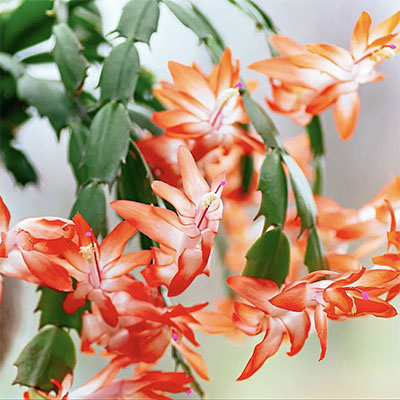
Thanksgiving Cactus
Schlumbergera truncata
Stems have a more serrated look than the Christmas or the Easter Cacti. Typically blooms in late November.
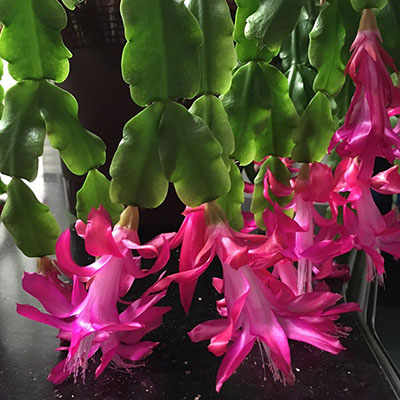
Christmas Cactus
Schlumbergera bridgesii
Stems have a slightly more rounded look than the Thanksgiving Cacti and can be distinguished from the Easter Cactus by their V-shaped stem base. Typically blooms in late December.
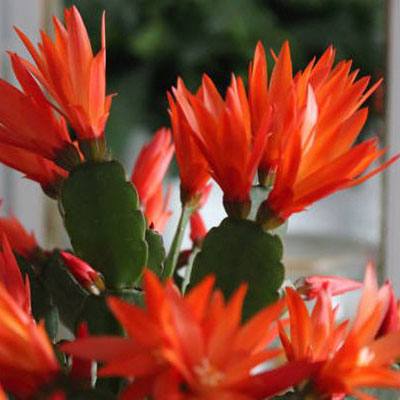
Easter Cactus
Rhipsalidopsis gaetneri
Stems have the most rounded form out of all the holiday cacti. Typically buds in February and blooms by Easter.
Plant Care
Light
Holiday cacti prefer partial shade or indirect sunlight. During the winter months, some direct light is acceptable as long as the sun is low in the sky; too much sunlight in the spring and summer can cause the plant to become pale and yellow.
Water
Though it is a cactus, its tropical origins make this plant crave more water than most. Water the plant thoroughly, allowing excess water to run out through the drainage holes. Let the soil dry almost completely between waterings. You will know if the soil is too dry when the leaves start to pucker and shrivel.
During a hot, sunny summer, water the plant two to three times a week. If the plant is located in a sunny window during the winter, it might need water once a week. To check the moisture level, place your finger 2 inches into the soil; if it’s dry to the touch, water thoroughly. If you keep the plant in a cooler location away from a window during the winter season, it might only need water once every two to three weeks.
Soil
Holiday cacti are adaptable to most soil conditions. Yours can thrive in loamy, sandy, perlite, cactus mix, or general-purpose potting soil. To achieve optimal growth, it prefers a pH level between 5.5 and 6.2; peat moss is a helpful additive for a more acidic environment.
Humidity
Holiday Cacti need ample humidity, especially when grown in the dry conditions of heated homes during the winter. Either mist the plant or place a pebble tray filled with water beneath the pot to boost its humidity levels.
Temperature
Temperature-wise, the Holiday cactus is a bit picky. During its peak growth months (April to September), it prefers balmy temperatures between 70 and 80 degrees Fahrenheit. Once the buds are set, it requires low nighttime temperatures (between 55 and 65 degrees Fahrenheit) and at least 13 hours of darkness to form buds that will flower. Keep it away from heating vents, frequently-opened doors, and drafty windows; this plant does not like to be exposed to sudden drafts or temperature changes and it will drop its buds or flowers if it’s unhappy.
Fertilizer
Feed your Holiday Cactus monthly with a half-strength, diluted water-soluble balanced fertilizer during the early spring and summer months. Once you’ve noticed the formation of flower buds—usually late summer or early fall—stop feeding it. After the plant blooms, you can resume monthly feedings.
Repotting
Holiday Cacti like to be rootbound and do not need to be repotted often—every three to four years is sufficient. Frequent repotting can damage the plant and can cause it to stop blooming for a while.
Unlike other plants that are best repotted in spring, it is best to wait until blooming ends and the flowers have wilted in late winter or early spring. Never repot the plant while it is actively blooming.
Pruning
You can safely prune your plant anytime after the plant blooms until late spring without harming the plant. Pruning will force the plant to branch out, and it will grow more of its distinctive stems.
To prune a Holiday cactus, give the stems a twist between one of the segments. You can also use a sharp, sterilized knife or scissors to remove segments. You can remove up to a third of the plant per year.
Flowering
Under the best conditions, plants bloom about 18 months after sowing from seed. Each flower will remain open for at least six days, and the plant should continue to bloom for four to six weeks. The best way to ensure that your plant remains in bloom throughout the winter is by deadheading or removing the faded flowers.
For your Christmas cactus to bloom during the holiday season, you might need to force it into dormancy, then coax it out. Here’s how:
- In mid-October, reduce watering (probably once every week or two). Only water when the soil feels dry about an inch below the surface. Stop fertilizing.
- Keep your Christmas cactus cool between 50 to 55 degrees Fahrenheit and make sure to limit the amount of light it gets for about six to eight weeks.
- During the day, the plant can receive indirect light, but it needs 12 to 14 hours of total darkness at night. If the room is warmer than 55 degrees Fahrenheit, give your plant an extra couple of hours of darkness each day. If light can reach the plant anytime during its 12 hours of “night,” cover the plant with a dark cloth.
- Once flower buds form, move the plant to a bright, draft-free window. Flowers should start opening within a couple of weeks.
Toxicity
Holiday Cacti are not considered to be toxic or poisonous.
Plant Problems
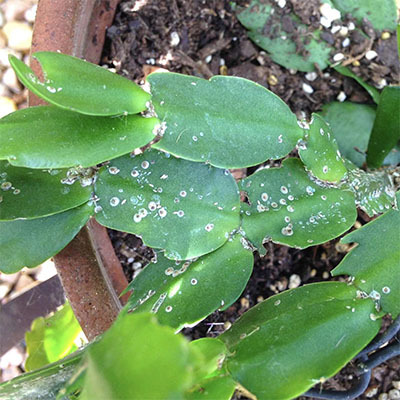
Common Pests
The most common pests that infect holiday cacti are fungus gnats, flower thrips, aphids, spider mites, and mealybugs. Do not overwater your plant; soggy soil is what most often attracts these pests. Insecticidal soap and horticultural oil are usually effective in controlling an outbreak. The tiny pests can also be removed by blotting them with an alcohol-soaked cotton ball. A Christmas cactus might not survive a heavy infestation and might need to be discarded, especially if there are other plants nearby.
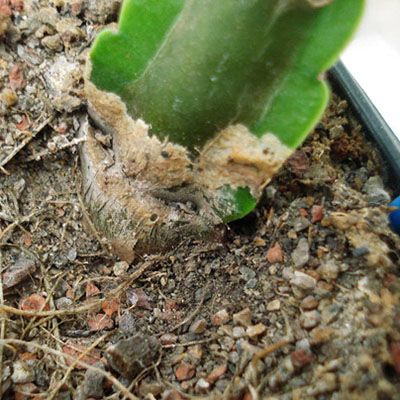
Fungal Diseases
Fungal diseases are common when plants are overwatered. Avoid overwatering to prevent fungal infections. Fusarium and Phytophthora are two common Christmas cactus fungi that can cause stem rot. Fusarium stem rot causes brown spots to form on the stem at the soil line. Phytophthora stem rot causes the stem to appear wet or water-soaked at the soil line. Phytophthora is deadly. A Christmas cactus might rebound from the fusarium if caught early enough, but it’s often hard to save. If the plant has overly wet soil, allow it to dry out, then apply a fungicide according to the package instructions.

Yellow, Spotted, & Wilting Leaves or Stems
If your plant has yellowing leaves or stems, leaf spotting, or plant wilting, inspect them closely for thrips. Thrips are an insect that looks like thin black slivers or tiny lobster-like insects. The leaf and stem damage is not caused directly by thrips but by a virus they commonly transmit, impatiens necrotic spot virus. Treat the thrip infestation with insecticidal soap or horticultural oil. The plant might rebound if you also remove it from its old container and into a sterilized container with fresh potting mix. Wilting can also be caused by too little light, insufficient water, or if the plant is rootbound. Correct those conditions and monitor closely for improvements.
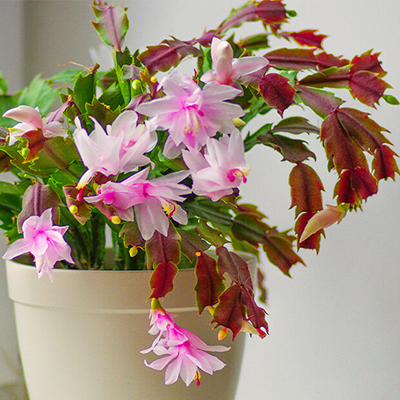
Leaves Turning Red or Pink
If the leaves of your Christmas cactus turn red or pink, it might either be receiving too much sun or too little water. If your plant is located in a window with direct sun, move it back to indirect light. If the soil is dried up to 1 inch deep, water it more frequently. The rule of thumb is to water a Christmas cactus when the top of the soil feels dry.
 |
| 
